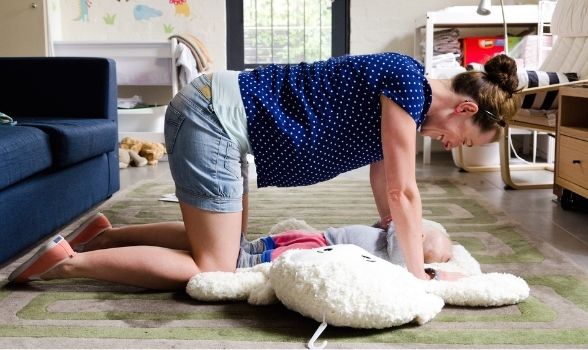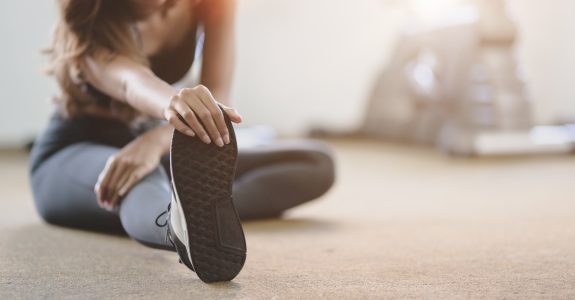
Return to Exercise After Childbirth: Benefits & Tips
Welcoming a new baby into your life is an incredible journey, filled with its own unique blend of joys…and challenges. As physiotherapists with a special interest in women’s health, one of the most common questions we get from new mums is, “When can I start exercising again?”
Returning to exercise after childbirth is a pivotal step towards regaining your strength, boosting your mental health, and enhancing your overall well-being.
Importantly, postpartum exercise, when approached thoughtfully and correctly, can be a cornerstone in supporting your pelvic health. It’s not about racing back to your pre-baby fitness level; it’s about gently guiding your body through a healthy and nurturing recovery.
At Growing Bones we are passionate about helping you navigate this journey with expertise and care to help gently lead your body through a healthy and nurturing recovery. In this guide, we will dive into the benefits of postpartum exercise, and share suggestions on how to make it effective, and enhance your overall quality of life.
Benefits of postpartum exercise:
1. Boost mental health
Exercise can be a powerful ally in managing postpartum depression and anxiety. It releases endorphins, the body’s natural mood lifters, helping new mums feel more relaxed and happier.
2. Strengthen the core and pelvic floor muscles
Regular and targeted exercises can significantly strengthen your core and pelvic floor muscles, which are essential for recovery after childbirth and for reducing the risk of lifelong pelvic floor related symptoms.
3. Improve cardiovascular health and overall fitness
Exercise, even in moderate amounts, can improve heart health, making it easier for you to keep up with your new baby and the demands of motherhood.
4. Build muscle strength and support weight management
Consistent exercise helps to regain muscle strength, and can be a beneficial part of a healthy weight management strategy post-childbirth.
5. Enhancing energy levels and improve sleep
Regular physical activity can boost your energy levels during the day and help you enjoy more restful sleep at night—a win-win for exhausted new mums!
Tips for return to exercise:
- It is crucial to listen to your body. Mild muscular fatigue might be normal when resuming exercise, but sharp or persistent pain is a sign to stop and consult a healthcare professional.
- Start with low-impact exercises. Begin your postpartum exercise journey with low-impact options like walking, swimming, or postnatal pilates. These exercises are gentler on your joints and pelvic floor.
- Do not skip the basics. Core and pelvic floor muscle exercises, should be foundational in your postpartum fitness plan.
- Take your time and progress at your own pace. We advise working with a physiotherapist that has a special interest in women’s health, or other qualified healthcare professionals to ensure your exercise plan is tailored to your individual situation.
The role of a pelvic floor & women’s health physiotherapist:
- The pelvic floor is a group of muscles, ligaments, and tissues that support your uterus, bladder, and bowel.
- After childbirth, these muscles become weakened or stretched, which can lead to issues such as incontinence, prolapse, or pain during intimacy.
- Our physiotherapists are dedicated to helping women regain control and strength in this critical area of your rehabilitation.
- Together, we work on a personalised plan, which may include exercises to strengthen the pelvic floor muscles, strategies to manage any pain or discomfort, and advice on returning to exercise and other daily activities.
- Remember, prioritising your pelvic health after childbirth isn’t just about resolving issues now—it’s about setting the foundation for a lifetime of well-being.
Types of recommended exercises postpartum:
Every woman’s body is unique, and so is her journey back to fitness after having a baby. The timeline below offers a general guide, but it is important to consult with a healthcare professional, like a women’s health physiotherapist, before starting any new exercise program.
0-6 weeks: Gentle beginnings
- Focus on gentle pelvic floor muscle training, to help start the process of rebuilding strength.
- Walking is also a fantastic option— it is low-impact, and is a wonderful way for you and your baby to get some fresh air and commence cardiovascular exercise.
6-12 weeks: Finding your feet
- At this stage, you may be able to introduce further light aerobic exercises, such as stationary biking or swimming (if given clearance).
- Continue and increase your pelvic floor strengthening exercises under guidance of a physiotherapist.
- Basic stretching and strengthening can also be introduced here, such as a postnatal specific pilates or yoga program. These workouts are fantastic for building core strength and improving posture without putting excessive strain on your body.
3-6 months: Building strength mindfully
- Gradually progress your program, increasing endurance, building on the range of exercises completed in classes, adding in resistance training, and continuing pelvic floor muscle rehabilitation.
- As your strength and stamina improve, you may wish to consider a review with our physiotherapists for a review prior to commencing high impact exercise.
- As always, continue to listen to your body, and work within the levels of fatigue without pain.
Beyond 6 months: Embracing more
- With physiotherapy clearance and a strong foundation of strength and endurance, you might be ready to move into higher impact exercises, such as jogging or group fitness classes. It is essential you do not have any pelvic floor related symptoms prior to commencing any high impact training.
Important note: It is crucial to consult with a healthcare professional before making significant changes to your exercise routine, especially postpartum. It is our job to ensure your transition back to exercise is effective, and tailored just for you.
Breastfeeding and Exercise
You might be wondering, “Can I exercise while breastfeeding? Will it affect my milk supply?” Good news—exercise and breastfeeding can absolutely go hand in hand, and doing so can have fantastic benefits for both your mental and physical well-being.
Benefits of exercise while breastfeeding:
- Exercise can help to reduce stress and improve your mood, thanks to those wonderful endorphins, making the challenges of new motherhood a bit easier to navigate.
- Being active promotes better sleep and increases energy levels, which is a lifesaver when you are caring for a new baby.
Tips to ensure comfort and milk supply:
- Time your workouts around your breastfeeding schedule. Aim to exercise after you’ve fed your baby so you’re comfortable and not overly full.
- Wear a supportive and comfortable sports bra that isn’t too tight to avoid putting pressure on your milk ducts.
- Stay hydrated and well-nourished. Exercise increases your fluid needs, which is especially important when you are breastfeeding.
General Exercise Safety Suggestions
When returning to exercise postpartum, safety should be your top priority. Here are some general tips to help you exercise effectively:
Warm-Up and Cool-Down Routines
Always start with a gentle warm-up, such as walking or stretching, to prepare your body for exercise, and end with a cool-down to help your body recover.
Staying Hydrated and Well-Nourished
Keep a water bottle handy during your workouts and focus on eating a balanced, nutritious diet to fuel your body effectively.
Avoiding Over-Exertion and Understanding Rest
Listen to your body and stop if something feels off. Rest is just as important as movement during this phase of life.
If you’re feeling excessively tired or sore or notice any signs of over-exertion, like dizziness or dehydration, it’s a sign to ease up and give your body a break.
When to be check in with a healthcare professional:
Exercise should generally make you feel better, not worse. It is essential to be aware of signs that may indicate you need to slow down or seek advice.
Importance of an individual assessment
It is vital to get the all-clear from your healthcare professional before starting or intensifying any exercise postpartum. They can provide an individualised plan based on your unique circumstances and recovery.
Identifying unusual pains and symptoms
If you are experiencing sharp, persistent, or increasing pain during or after exercising, it’s time to pause and consult with a healthcare professional. Any unusual soreness beyond normal muscle fatigue should be taken seriously and discussed with your healthcare provider.
Post-exercise bleeding:
Any new or increased bleeding after post partum workouts should be discussed with your general practitioner or obstetrician.
Recognising signs of pelvic floor dysfunction:
If you notice symptoms like such as bladder or bowel incontinence or urgency, pain during intimacy, or a heavy, dragging feeling in the pelvic area, it is important to consult with a pelvic floor physiotherapist, such as one from our team at Growing Bones.
We can create a personalised plan that allows you to keep active, but safeguards your pelvic floor health, targets your specific needs, and sets you up for long-term success.
At Growing Bones, we take a team approach. We also work closely with our osteopath practitioners, nutritionist, and massage therapist to guide you toward a strong, and healthy life postpartum.
Postpartum Workout FAQs
What exercise is advisable 2 weeks postpartum?
At 2 weeks postpartum, focus on rest and recovery. Gentle pelvic floor exercises and short walks may be beneficial but always consult with a healthcare professional first.
When to start exercise after normal delivery with stitches?
Wait until your 6 week check-up and get clearance from your doctor, especially when you have had stitches. Gentle pelvic floor exercises and walking can often start sooner.
Is this the same for a caesarean section?
Yes. Every woman’s caesarean section recovery is different, but generally it is advisable to wait until you have been cleared by your healthcare professional, which is usually after 6 weeks postpartum to commence any exercise beyond walking and pelvic floor muscle training.
Moving ahead with confidence:
Congratulations on this beautiful new chapter of your life! As a new mum, your body has done something extraordinary, and it deserves respect, patience, and loving care. Remember, the journey back to fitness isn’t a race; it’s a meaningful, step-by-step progression.
The long-term benefits of exercise after childbirth are immense, from boosting your mental health to strengthening your postpartum pelvic floor and core muscles. It’s about feeling strong, energised, and comfortable in your own skin.
Patience and persistence are your best allies. It’s essential to follow a structured, effective pelvic floor exercise postpartum plan, especially under professional guidance like ours at Growing Bones. Are you ready to move ahead with confidence and care? Book a women’s health physio session with our physiotherapists at Growing Bones, and let’s embrace this journey together.
